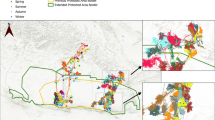Abstract
Based on a case study from Ferlo in Senegal, this paper discusses how pastoral mobility can be studied and understood with special emphasis on the use of GPS data. It has a dual objective: first, to investigate the methodological potential of using GPS data; second, to discuss the analytical use of GPS data for understanding mobility. The methodological potential for using GPS data is related to quantifying mobility and characterizing mobility patterns in space and time. Analytically, GPS data can be used in combination with qualitative information to make method triangulation. The GPS data can be used both prior to qualitative interviews to make informed questions about mobility and they can be used after qualitative investigations to illustrate points made or to reveal inconsistencies. The study shows that cattle walk about 5000 km per year (excluding night grazing) and different mobility patterns occur depending on the season. Issues such as “the cattle complex” and the notion of the independent, nomadic pastoralist are discussed in relation to pastoral mobility. Although cattle are of major importance to the Fulani, it is not important for them to walk with their animals, which are left to roam freely or supervised by paid herders. It is necessary to take into account all these issues if we want to go beyond the simple understanding of mobility as a means to find pasture and water.
Similar content being viewed by others
REFERENCES
Adriansen, H. (1999). Pastoral mobility as a response to climate variability in African dryland. Danish Journal of Geography 1(special issue): 1–10.
Adriansen, H. K. (2001). A Fulani Without Cattle is Like a Woman Without Jewellery: A Study of Pastoralists in Ferlo, Senegal. PhD Thesis, Institute of Geography, University of Copenhagen.
Alissoutin, R. L. (1997). Pond management in the Podor department, Senegal, IIED Drylands Programme, Issue Paper 72.
Ayantunde, A. A., Williams, T. O., Udo, H. M. J., Fernández-Rivera, S., Hiernaux, P., and van Keulen, H. (2000). Herders' perceptions, practice, and problems of night grazing in the Sahel: Case studies from Niger. Human Ecology 28(1): 109–130.
Ba, C. (1986). Les Peuls du Senegal. Etude geographique, Les Nouvelles Editions Africaines, Dakar.
Barral, H. (1982). Le Ferlo des forages, ORSTOM, Dakar.
Behnke, R. H., Scoones, I., and Kerven, C. (eds.) (1993). Range Ecology at Disequilibrium, New Models of Natural Variability and Pastoral Adaptation in African Savannas, Overseas Development Institute, International Institute for Environment and Development, Commonwealth Secretariat, Nottingham.
Bourdieu, P. (1984). Distinction:ASocial Critique of the Judgement of Taste, Routledge, London.
Bovin, M. (1990). Nomads of the drought: Fulbe and Wodabee nomads between power and marginalization in the Sahel of Burkina Faso and Niger Republic. In Bovin, M., and Manger, L. (eds.), Adaptive Strategies in African Arid Lands. Proceedings from a seminar at the Scandinavian Institute of African Studies, Motala, SIAS, pp. 29–57.
Chatty, D. (1986). From Camel to Truck: The Bedouin in the Modern World, Vantage Press, New York.
Cribb, R. (1984). Greener pastures: Mobility, migration and the pastoral mode of subsistence. Production pastorale et société 14: 11–46.
Ellis, J. E., Cougenour, M. B., and Swift, D. M. (1993). Climate variability, ecosystem stability, and the implications for range and livestock development. In Behnke, R. H., Scoones, I., and Kerven, C. (eds.), Range Ecology at Disequilibrium—New Models of Natural Variability and Pastoral Adaptation in African Savannas, Overseas Development Institute, Nottingham, pp. 31–41.
Ellis, J. E., and Swift, D. M. (1988). Stability of African pastoral ecosystems: Alternative paradigms and implications for development. Journal of Range Management 41: 450–459.
Equipe ECOSSEN (1997). Crises de l'environnement et dynamique des espaces ruraux du nordouest Sénégalais. Rapport technique à 3 ans. Université Cheikh Anta Diop, IFAN, Laboratoire de Géographie; Project ECOSSEN, subventionné par le CRDI, Ottawa, Canada; Universit´e de Sherbrooke, CARTEL.
Freudenberger, M. S., and Freudenberger, K. S. (1993). Pastoralism in Peril: Pressures on Grazing land in Senegal, IIED Drylands Programme, Pastoral Land Tenure Series No. 4.
Herskovits, M. J. (1926). The cattle complex in East Africa. American Anthropologist 28: 230–272, 361–388, 494–528, 633–644.
Irons, W. (1968). The Turkmen nomads. Natural History 77: 44–51.
Johnson, D. J. (1969). The nature of nomadism: A comparative study of pastoral migration in Southwestern Asia and Northern Africa, Research paper No. 118, Department of Geography, University of Chicago.
Le Houérou, H.N. (1989). The Grazing Land Ecosystems of the African Sahel, Springer-Verlag, Berlin.
Mitchell, C. J. (1983). Case and situation analysis. The Sociological Review 31(2): 187–211.
Naimir-Fuller, M. (ed.) (1999). Managing Mobility in African Rangelands, the Legitimization of Transhumance. Food and Agriculture Organization of the United Nations, Beijer International Institute of Ecological Economics, IT Publications, Exeter.
Santoire, C. (1983). Raison pastorale et developpement: Les societ é Peuls face au amenagment, Travaux et documents de l'ORSTOM no. 166, Dakar, ORSTOM.
Sayer, A. (1992). Method in Social Science: A Realist Approach, 2nd edn., Routledge, London.
Scoones, I. (ed.) (1995). Living With Uncertainty: New Directions in Pastoral Development in Africa, Intermediate Technology Publications, Exeter.
Stenning, D. J. (1957). Transhumance, migratory drift, migration; patterns of pastoral Fulani nomadism. Journal of theRoyal Anthropological institute of Great Britain and Ireland 87(1): 57–73.
Swallow, B. (1994). The role of mobility within the risk management strategies of pastoralists and agro-pastoralists, IIED Gatekeeper Series no. 47.
Touré, O. (1990). Where herders don't herd anymore: Experience from the Ferlo, Northern Senegal, IIED Dryland Networks Programme Paper No. 22.
Author information
Authors and Affiliations
Corresponding author
Rights and permissions
About this article
Cite this article
Adriansen, H.K., Nielsen, T.T. Going Where the Grass Is Greener: On the Study of Pastoral Mobility in Ferlo, Senegal. Human Ecology 30, 215–226 (2002). https://doi.org/10.1023/A:1015692730088
Issue Date:
DOI: https://doi.org/10.1023/A:1015692730088




